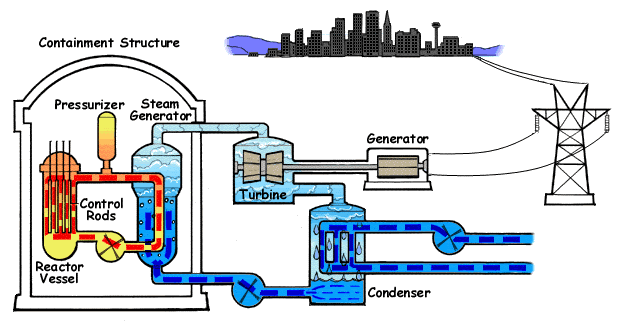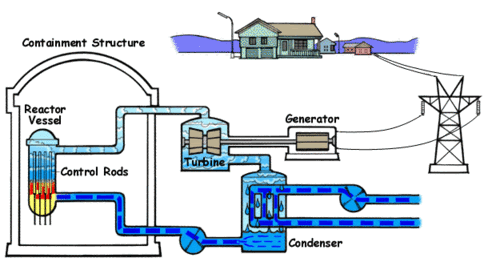What Impact has Fukushima had on public opinion?
The Fukushima accident has had an impact on public opinion. However, though it is very difficult to assess this impact in the long-term, it can already be said that the results of opinion polls carried out throughout Europe after the event show that it is very country specific. In some countries, like Germany and Switzerland, opposition to nuclear has risen sharply, while in others where new build plans are under way, like the United Kingdom (UK) or France, a majority of the population still backs the use of nuclear power. The opinion poll carried out by Ipsos MORI in May 2011 shows that in nine (Belgium, France, Germany, UK, Hungary, Italy, Poland, Spain and Sweden) out of the 27 Member States less than one fifth of those opposed to nuclear have been influenced by the accident. Furthermore, in a number of countries like the UK, the Netherlands, Spain, Switzerland and France, after a dip just after the accident, public acceptance of nuclear has recovered.
Before the accident occured, public acceptance had been increasing and the latest Eurobarometer on
Radioactive Waste published in July 2008, even showed that there were almost as many citizens in favour
of nuclear energy (44%) as against it (45%). This was due mainly to the fact that people were more
concerned with climate change and security of supply issues. It also showed a huge gap between views
expressed in countries with an anti-nuclear culture such as Austria, Cyprus, Malta and Portugal, and those
in countries where support for nuclear is strong like Hungary (63%), Sweden (62%), the Czech Republic
(64%) and Lithuania (64%). Moreover, when it is not making headlines, nuclear energy is not people’s main
preoccupation. It is a “back-of-the-mind” issue, which implies that people’s attitudes can change quickly and
are heavily influenced by the way the questions are phrased.
Despite the accident in Japan, nuclear’s credentials remain unaffected. Nuclear power is a base-load low carbon source of energy and can contribute to the fight against climate change. It is also a competitive
source of energy and can help reduce energy dependency.
Therefore, whatever opinion polls reveal, it is vital that politicians take the lead and implement bold decisions regarding the energy mix. Developments in Finland or the United Kingdom demonstrate that if the political decision to include nuclear in the energy mix is taken and information is communicated in an open, inclusive and democratic way, people tend to become more favourable to nuclear power.
Experienced nuclear countries
In France, UK, Spain, Finland and Sweden nuclear policies are diverse. Countries such as Finland, UK and France have clearly opted for nuclear power as a means to secure their energy supply and ensure energy independence. Public opinion usually supports nuclear in these countries. Sweden and Spain pursued other options.

France is the world’s largest nuclear power generator on a per capita basis and ranks second in total
installed nuclear capacity behind the United States. France has 58 nuclear reactors that produce 74% of
the total electricity. There is currently one nuclear reactor, a European Pressurised Reactor (EPR), under
construction at Flamanville, which is scheduled to come into operation in 2016 and one reactor planned at
Penly. After Fukushima, the French government reaffirmed its commitment to nuclear new build.
After the Japanese accident, an opinion poll carried out by BVA/Win-Gallup International revealed that a
majority of citizens are still in favour of nuclear (58%). However, the same poll carried out before Fukushima
found that 66% were favourable to nuclear before Fukushima. So public acceptance has decreased.
France

Public support for nuclear power has always been quite strong in France. The French state is centralised
and the decision in the 1970’s to choose nuclear power in order to reduce energy dependency was applied
to the whole territory. 58 nuclear reactors are operational on French territory, which means that nearly every
French citizen lives close to a nuclear power plant. School and industry trips are organised to visit nuclear
power plants (NPPs). People are, therefore, better informed about nuclear power and, consequently, less
resistant to it.
The government and the nuclear companies (Areva, EDF) have carried out various pro-nuclear campaigns
to foster public acceptance. Furthermore, the nuclear reactors have always been operated safely. Even if
the French still believe that nuclear activities are risky (55% think that the risk of severe nuclear accidents is
high), they do trust national authorities with controlling and ensuring the safe operation of nuclear reactors.

Finland has chosen to expand its nuclear power capacity. Finland has two NPPs, each with two reactors, and in 2010 nuclear energy accounted for 28% of total electricity production. In 2002, the Finnish government gave permission for the building of a new NPP unit, Olkiluoto 3, which will be the fifth reactor in the country and is scheduled to start commercial operation in 2014. In April 2010, the Finnish government gave its “preliminary permission” to the Finnish companies, TVO and Fennovoima, to build two more nuclear reactors (sixth and seventh reactors); a decision that was ratified by the Finnish Parliament in July 2011. Public opinion is in favour of nuclear, since 61% of the Finns polled in the Eurobarometer on Radioactive Waste declared that they were in favour of nuclear energy.

Explanation
In Finland, the debate on nuclear started in 2001. Consultations took place and the decision to build a new
reactor was taken by the Finnish parliament. Although there was no referendum, citizens were very well
informed about the issue and an open public debate took place. The Finns are pragmatic. that the best solution to address both climate change and security of supply issues (over-dependence upon
Russia) was to use nuclear power. Furthermore, the arguments against nuclear power (i.e. that dismantling
is too expensive and that waste cannot be effectively managed) were proven wrong: the nuclear industry
pays for the dismantling of NPPs at the end of their life-time (enough money has already been set aside)
and a final repository in the Finnish bedrock has been selected in an open and democratic way to dispose of
the waste produced by the reactors already in operation.

The UK has 18 nuclear reactors generating 16% of its electricity. The UK’s nuclear fleet is nearing the end of
its lifetime. Therefore, the UK government has decided to replace the ageing NPPs by a new fleet to ensure
continued security of supply and reduce carbon dioxide emissions.
According to an opinion poll conducted by Ipsos MORI6 and published in December 2010, 70% of UK
citizens supported a balanced energy mix that includes nuclear power. The same opinion poll published in August 2011 shows that this number has slightly decreased to 68%. However, after a dip in July 2011 (from
47% in December 2010 to 36% in July) support for nuclear new build has recovered and is now even higher
(50% in December 2011) than what it was before the accident
Explanation:
Oil reserves are dwindling in the North Sea. As a result, oil prices are rising and the UK’s security of energy supply is being threatened. People consider that nuclear power is a means of addressing this issue. The energy debate that has been going on in the UK since May 2005 has helped inform people about the issue and increase public acceptance. UK citizens are also more concerned with environmental issues and especially climate change. They are also aware that renewables alone are not sufficient to tackle energy and environmental issues.
CONCLUSION:
It is pointless to oppose nuclear energy and other sources of energy such as renewables. Nuclear must
be part of the energy mix. The nuclear energy expansion will continue to gather momentum if there is the
political will to promote it.
Public opinion evolves quicker than it is usually assumed (e.g.: UK, Finland). Like with many “back-of-the mind”issues, people’s attitudes towards nuclear energy are relatively unfixed and heavily influenced by
recent news and by the way the questions are put. “There is little reason to believe that if the technical,
environmental and economic case for nuclear energy is strong enough, popular opposition would act as an
insuperable barrier.” (Malcolm Grimston, Associate Fellow with the Sustainable Development Programme, Chatham House, London.)
The accident at Fukushima led, understandably, to a temporary decrease in public confidence in nuclear
energy in some countries. This might result in extra short-term costs for new build programmes. However,
public support has generally held up well and these factors should not decisively effect nuclear energy’s contribution to Europe’s energy mix. When it comes to making energy choices, the inescapable benefits of
nuclear energy will continue to speak for themselves.
Governmental campaigns, energy policy reviews and public debates play a major role in shaping public
opinion. Those events relayed via the media are a means of better informing European citizens and information is key to gaining public acceptance. Governments and policymakers should be encouraged to undertake such action.



 2 neutrons + 92Kr + 142Ba + ENERGY
2 neutrons + 92Kr + 142Ba + ENERGY


























